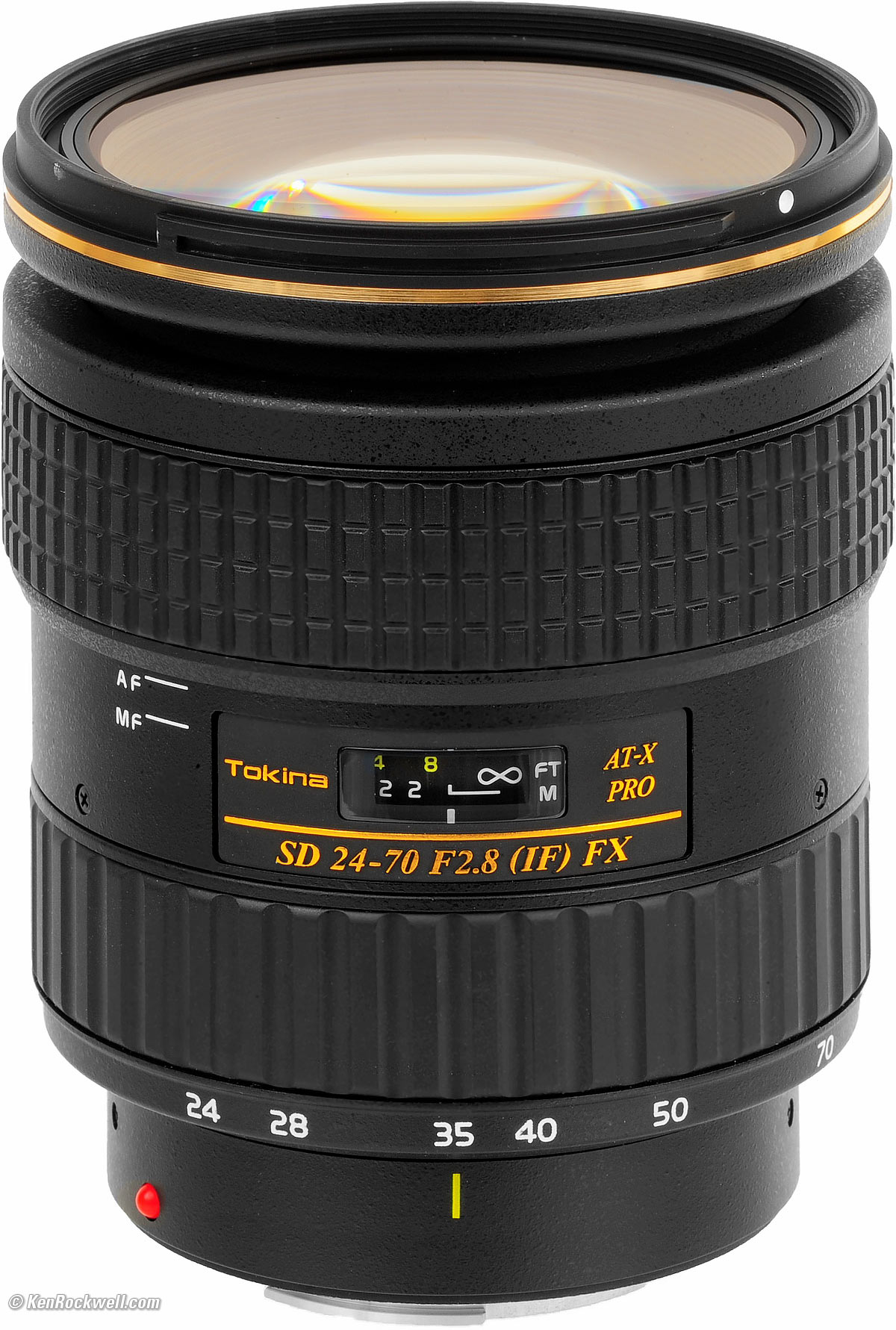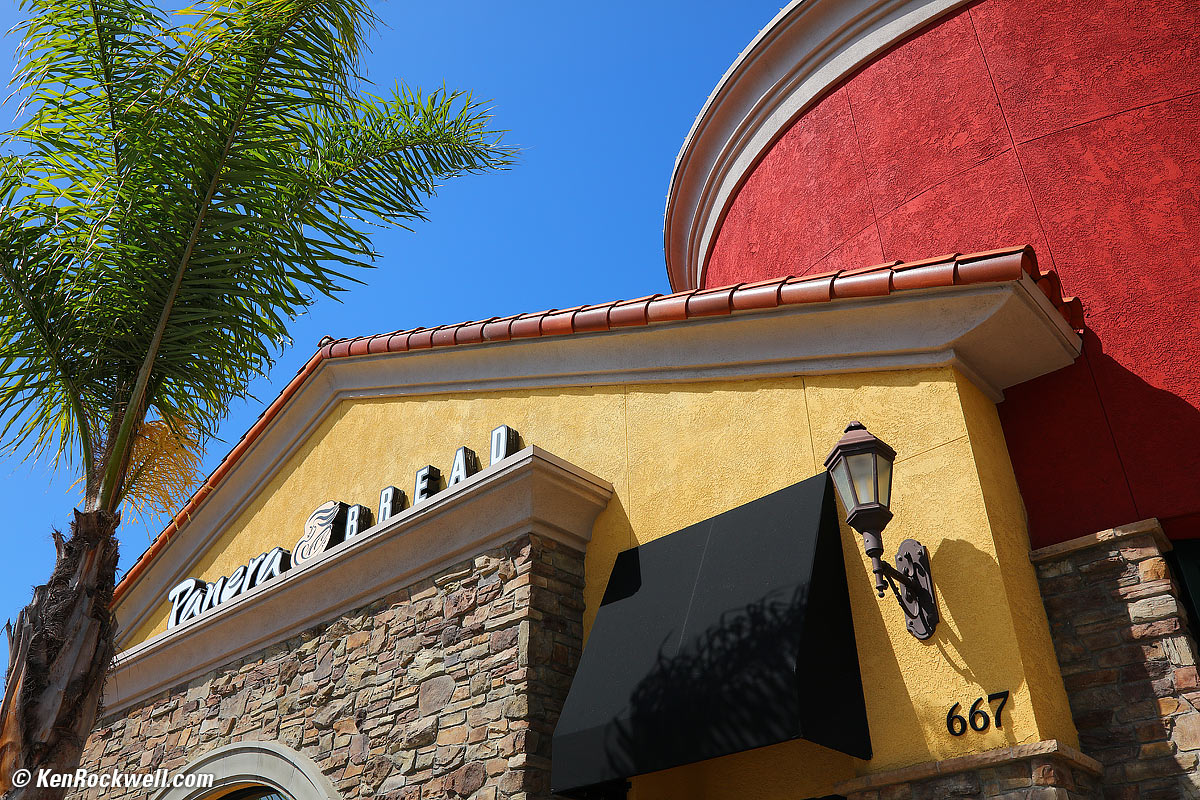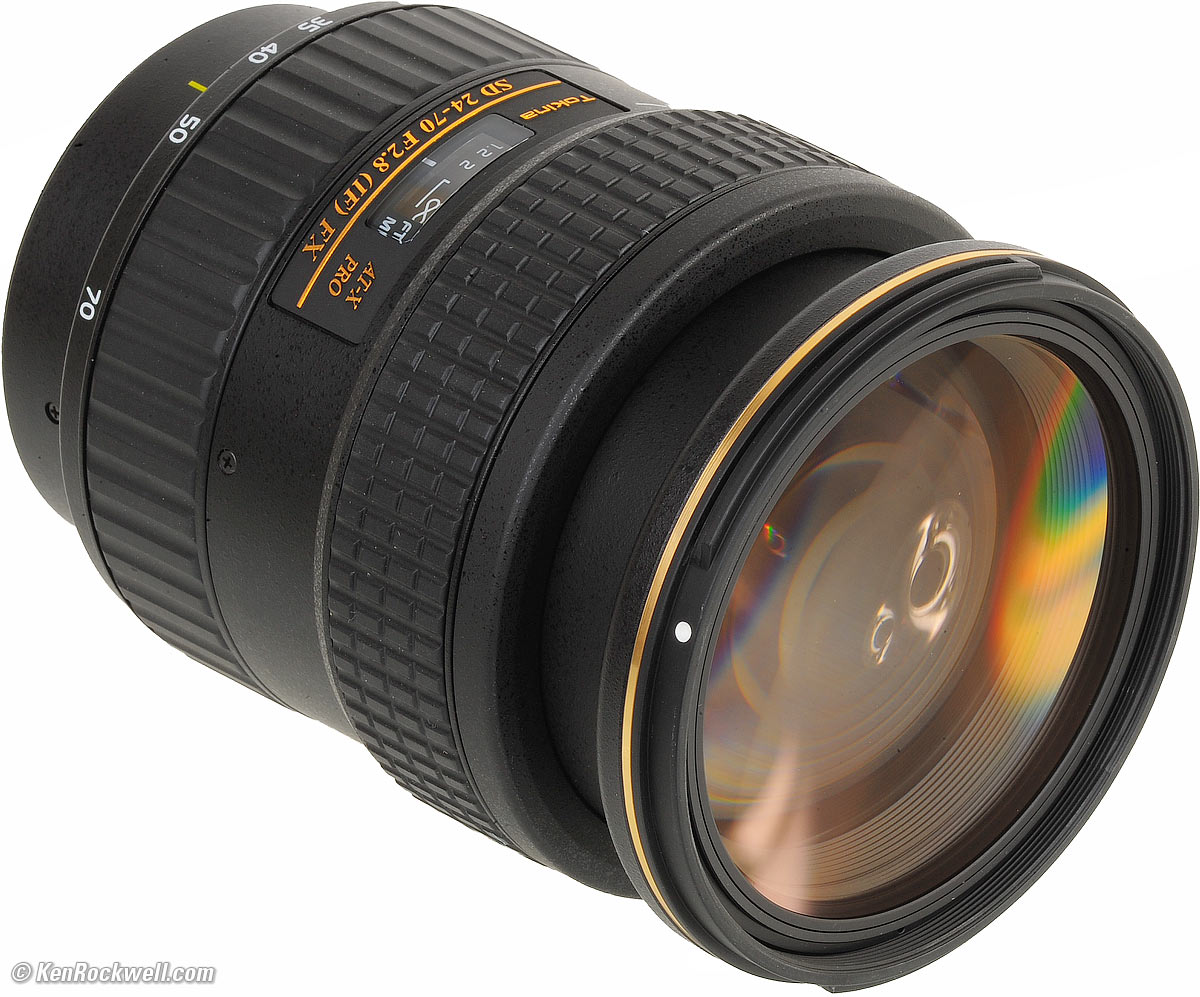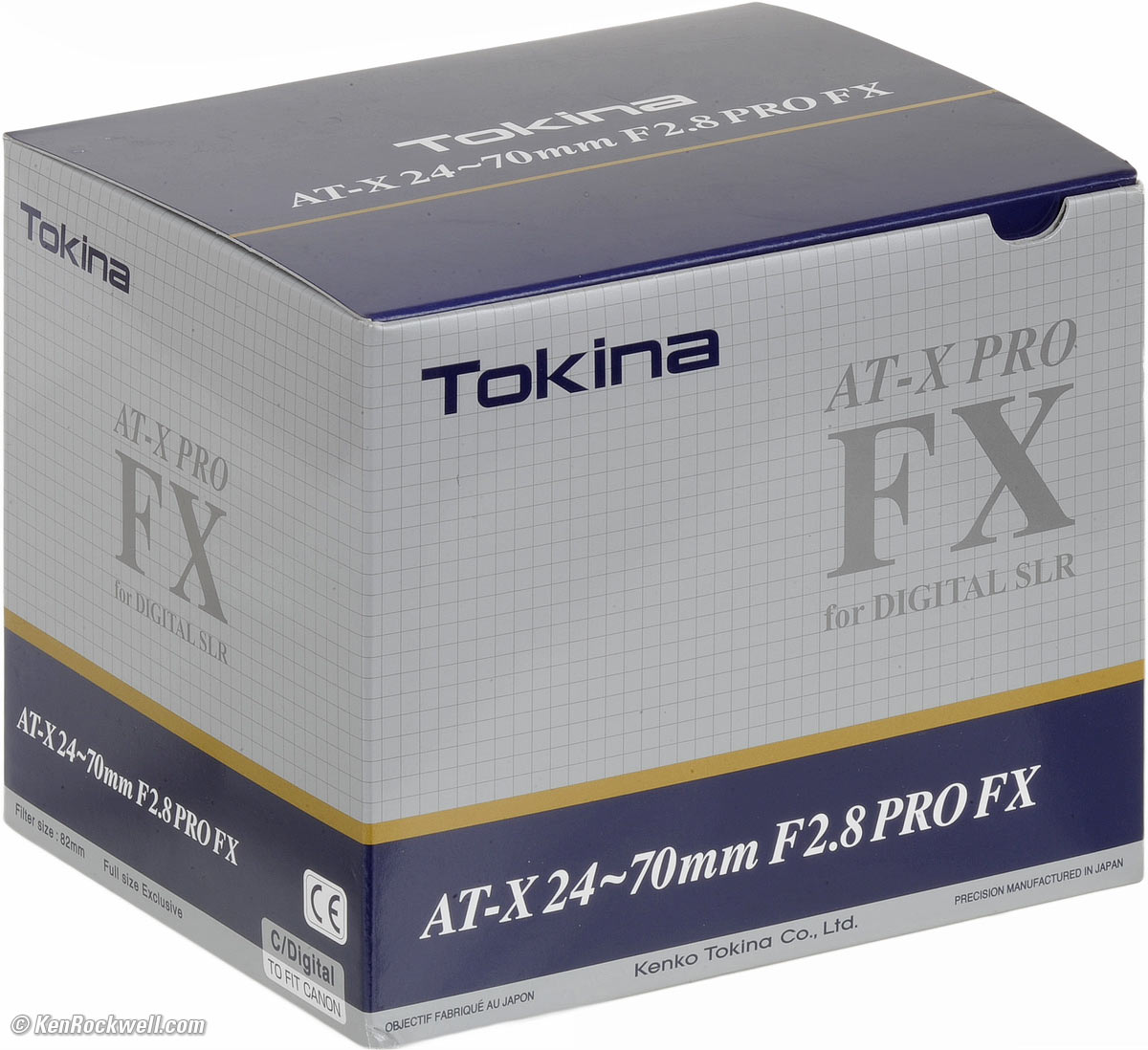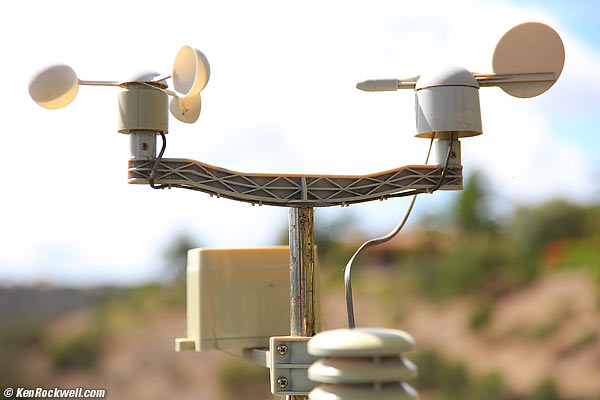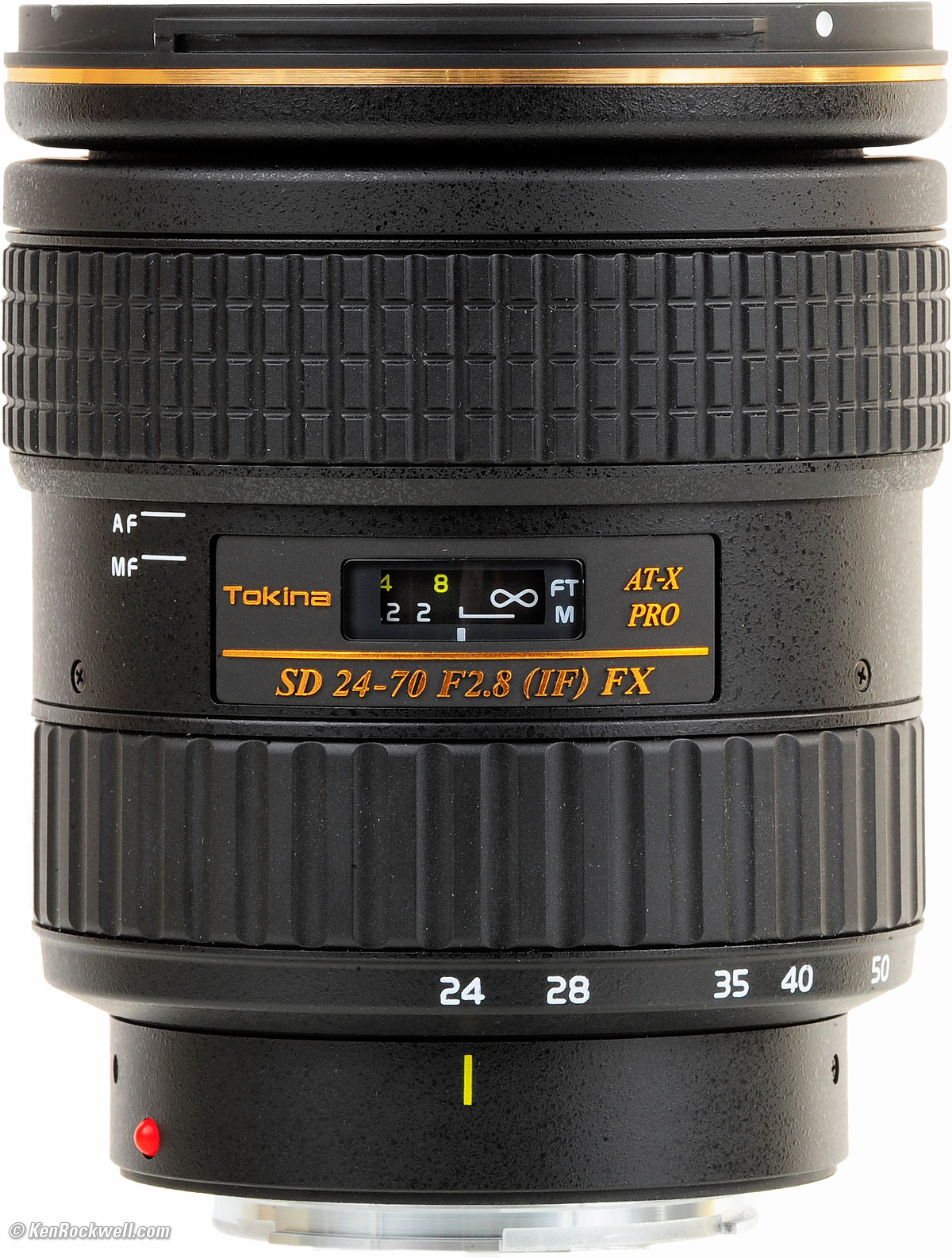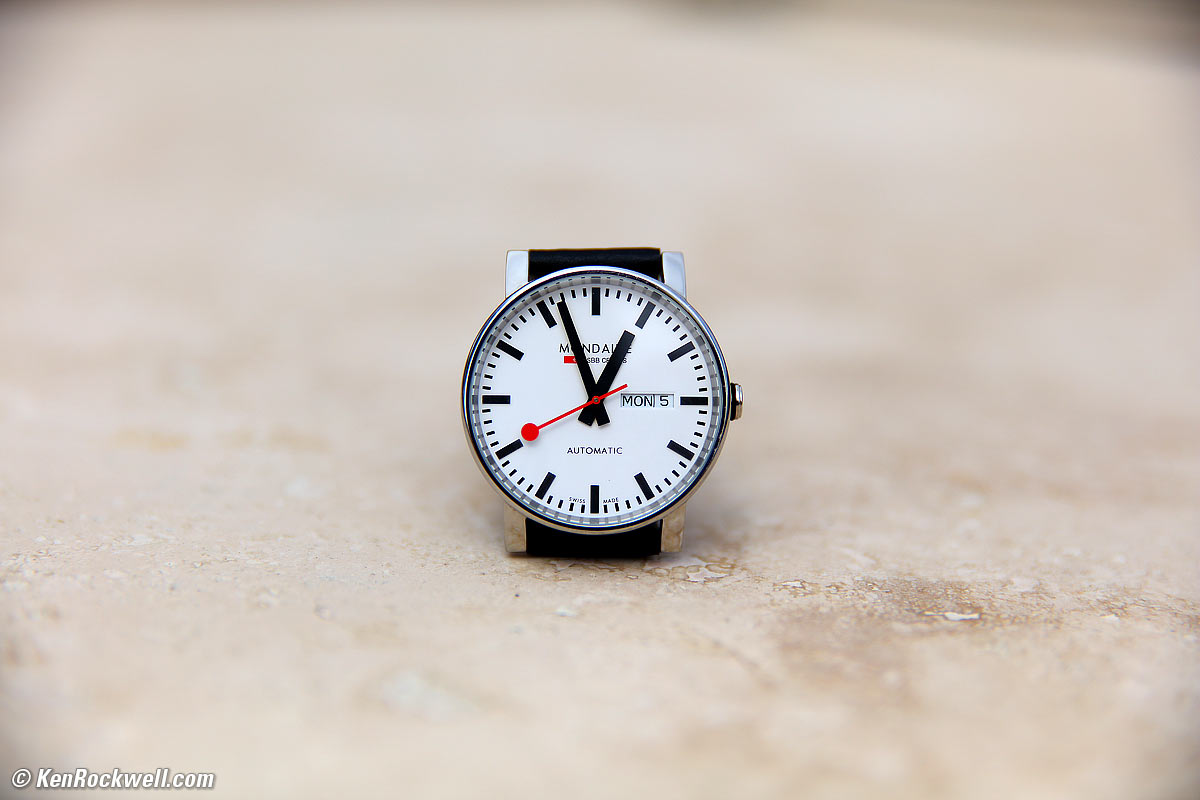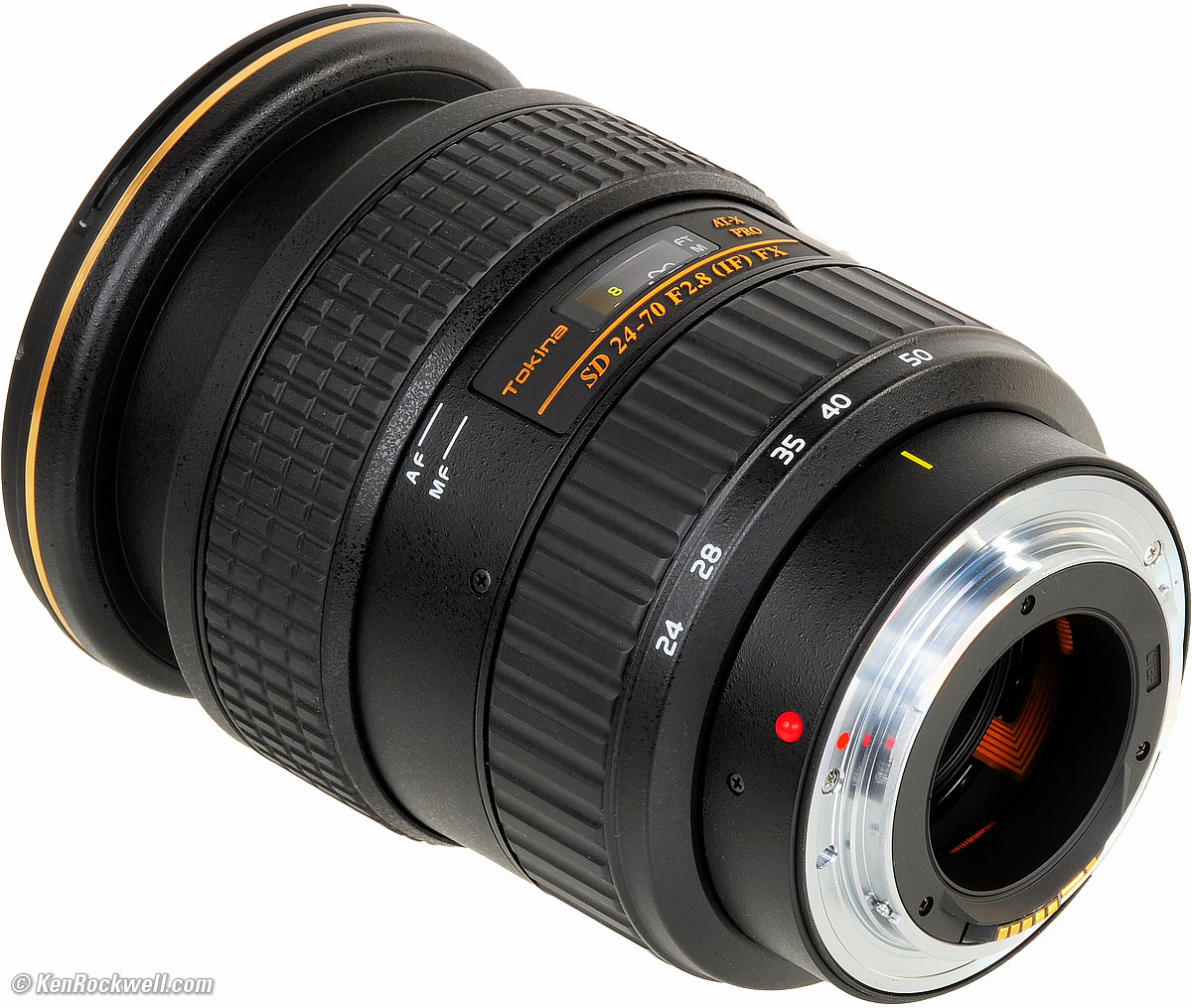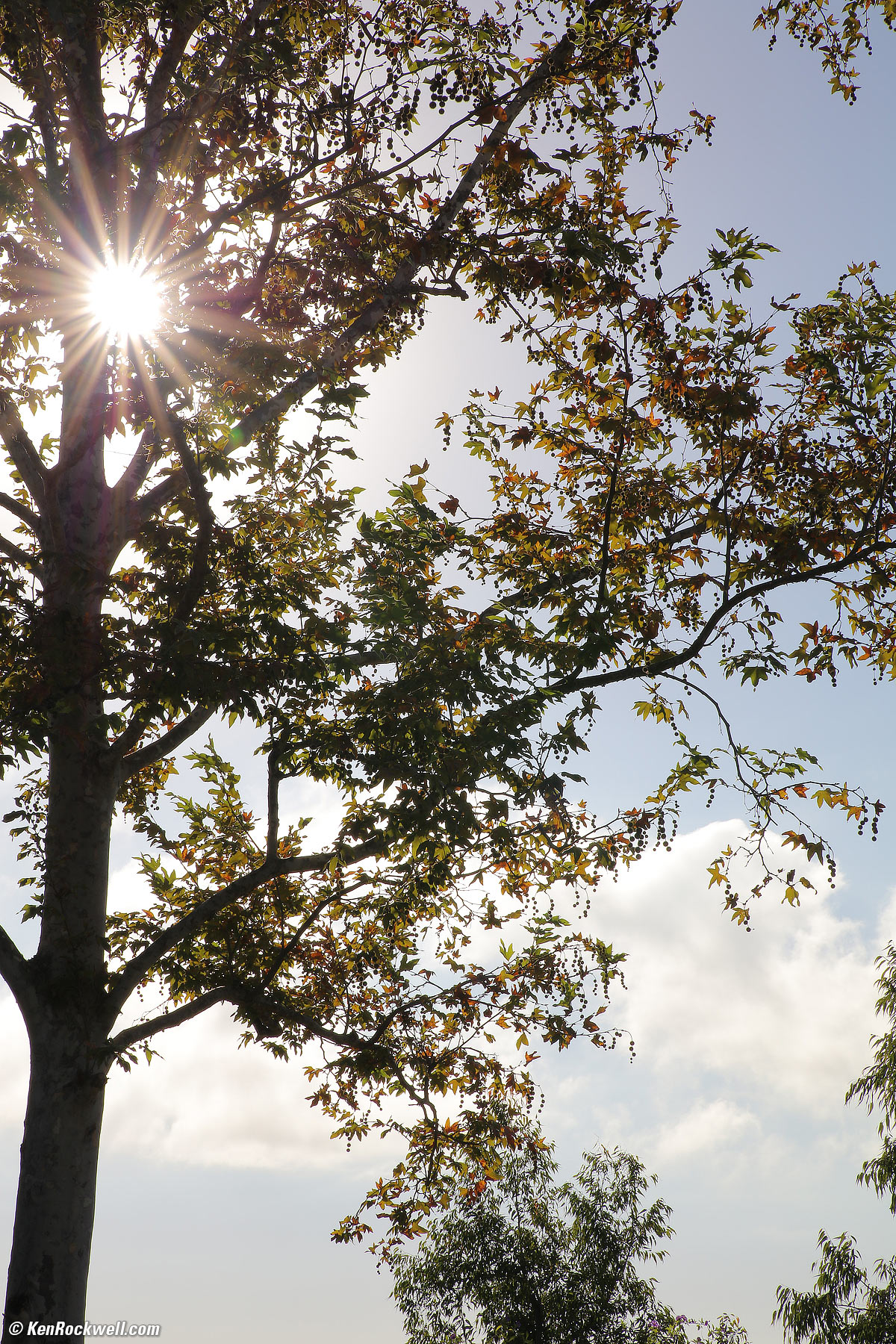Home Donate New Search Gallery Reviews How-To Books Links Workshops About Contact
Tokina 24-70mm f/2.8
Ultrasharp Full-Frame AT-X (2015-)
Sample Images Intro Specs Performance
Compared Usage Recommendations More
Tokina AT-X 24-70mm f/2.8 PRO FX (in Canon mount, also comes in Nikon mount; full-frame, APS-C and 35mm film coverage, 82mm filters, 35.8 oz./1,016g, 1.3'/15"/0.38m close focus, about $999). enlarge. I got mine at Adorama; I'd also get it at Amazon or at B&H.
This all-content, junk-free website's biggest source of support is when you use those or any of these links to approved sources when you get anything, regardless of the country in which you live. Tokina's boxes are not sealed in any way, so never buy at retail or any source not on my personally approved list since you'll have no way of knowing if you're missing accessories, getting a defective, store demo, damaged, dropped, returned or used lens. My approved sources ship from remote automated warehouses where no one gets their greasy fingers on your new lens before you do. Buy only from the approved sources I use myself for the best prices, service, return policies and selection. Thanks for helping me help you! Ken.
January 2016 Tokina Nikon Canon Fuji Sony Zeiss All Reviews
Tokina 28-70mm f/2.8 (c. 1990)
Nikon 24-70/2.8 G (2007-2015)
Nikon 24-70/2.8 VR (2015-)
Canon 24-70/2.8 L II (2012-)
Canon 24-70/2.8 L (2002-2012)
Sample Images (more later in the review) top
Sample Images Intro Specs Performance
Compared Usage Recommendations More
Approaching Autumn Storm, Hudson Valley, 7:13AM, 05 October 2015. Canon 5DSR, Tokina AT-X 24-70mm f/2.8 at 60mm, f/8 at 1/50 at AUTO ISO 100. bigger or 50MP © camera-original file to view on your desktop computer.
Strip Mall, 03 October 2015. Canon 5DSR, Tokina AT-X 24-70mm f/2.8 at 31mm, f/9 at 1/320 at AUTO ISO 100. bigger or 50MP © camera-original file to view on your desktop computer.
Palms, 03 October 2015. Canon 5DSR, Tokina AT-X 24-70mm f/2.8 at 41mm, f/11 at 1/80 at AUTO ISO 100. bigger or 50MP © camera-original file to view on your desktop computer.
Introduction top
Sample Images Intro Specs Performance
Compared Usage Recommendations More
|
Adorama pays top dollar for your used gear. I buy only from these approved sources. I can't vouch for ads below. |
This Tokina 24-70mm f/2.8 is a big, tough, well-made lens with superb optical quality. It has all metal innards and feels like it, too. Its optics are good enough for use even with the 50MP Canon 5DSR.
It is optically superb, better than Canon's 24-70/2.8 L (2002-2012), the same as Nikon's 24-70/2.8 G (2007-2015), and almost as good as Canon's stunning 24-70/2.8 L II (2012-). However, this Tokina's autofocus isn't as fast and you will hear a small motor running while it works.
If great optics are important and price matters, this new Tokina is a screaming deal. However, this lens is much heavier and slower to focus than any of Nikon or Canon's similar f/2.8 zooms.
While Nikon and Canon's 24-70 f/2.8s offer instant manual-focus override, you have to pull the Tokina's focus ring towards you to click into manual mode. It's fast, but by no means instant. This focus ring trick is faster than having to use the separate switch on Canon or Nikon.
This new Tokina looks similar to Tokina's older 28-80/2.8, 28-70/2.8, 28-70/2.6-2.8 and 28-70mm f/2.8, but has optics worlds better.
This lens, just like Nikon and Canon's best pro zooms, is super-sharp and contrasty even wide-open at f/2.8, while Tokina's earlier lenses all were much less contrasty wide open. This new 24-70/2.8 is stunning, even wide-open.
This isn't your dad's Tokina. Even at f/2.8, this is an insanely sharp lens. Look at the camera-original files shot at f/2.8 under Bokeh on your desktop computer for some of the sharpest spider webs you've seen.
As a full-frame lens, I am reviewing it on full-frame bodies. You may make the usual inferences when used with cropped sensors.
It works great with every camera I tried it. The risk you take with this off-brand lens is that ten years from now it might or might not be compatible with a new Nikon or Canon, since Nikon and Canon don't ensure that their new designs are backwards compatible with third-party lenses as they do for their own lenses.
I haven't tried this lens on every camera personally; there is the possibility of problems, but no worries, get yours from any of my personally approved sources and they'll return your money if you just don't like it for any reason.
Nikon
Everything should work perfectly on every digital Nikon ever made, both FX and DX, from the best Df, D4s, D810, D750 and D610 to Nikon's cheapest digitals like the D40, D40x, D60, D3000, D3100, D3200, D3300, D5000, D5100, D5200, D5300 and D5500.
It also should be perfect on decent or recent AF film cameras like the F6, F100, F5, N80 and N75.
The incompatibilities for older or cheaper 35mm cameras are that:
1.) It won't autofocus with the cheapest new AF 35mm cameras like the N55, but if you focus manually, everything else works great. Even if you lose autofocus, these cameras have in-finder focus confirmation dots to help you.
2.) Late 1980s ~ early 1990s AF cameras like the N90s, N70 and F4 will focus just fine. You'll have Program and Shutter-priority modes, but lose Manual and Aperture-priority since you have no way to set the aperture on the camera or on the lens.
3.) You're really pushing it with the oldest AF cameras like the N2020, N6006 and N8008. You'll have no AF and confused exposure modes. Manual focus is fine, along with electronic focus indications.
4.) Since it has no aperture ring, it's just about useless with manual focus film cameras. It will shoot every shot at its minimum aperture.
See Nikon Lens Compatibility for details with your camera. Read down the "AF-S, AF-I" and "G" columns for this lens. You'll get the least of all the features displayed in all columns, since "G" (gelding) is a deliberate handicap which removes features and compatibility.
Canon
As an EF-compatible lens, it works on every Canon EOS camera ever made, regardless of sensor size, film or digital.
Of course it works great on today's Canon 5DS R, 6D and Canon 7D Mk II.
I actually tried it on my original 1987 Canon EOS 650, and it works perfectly on it, too.
Specifications top
Sample Images Intro Specs Performance
Compared Usage Recommendations More
Tokina 24-70/2.8. bigger.
Name
Kenko Tokina calls this the Tokina AT-X 24-70mm f/2.8 PRO FX (IF) SD.
AT-X: Advanced Technology-seX.
PRO: Push-pull mechanical clutch mechanism on the focus ring to swap between auto and manual focus.
FX: Covers all 35mm-based "full frame" and smaller digital formats.
IF: Internal focus; nothing moves externally as focussed.
SD: Super-low Dispersion glass for less secondary chromatic aberration.
Optics top

Tokina 24-70mm f/2.8 Construction.
15 elements in 11 groups.
Three glass molded aspherical elements.
Three ED (a.k.a. UD or SD) glass elements.
Internal focus: nothing moves externally as autofocused.
Pumper zoom, grows as zoomed towards 70mm.
Multicoated.
Focal Length top
24 ~ 70mm.
On Nikon DX it will see angles-of-view similar to what a 35 ~ 105mm lens would see on a 35mm or full-frame camera.
On 1.3x Canon cameras it will see angles-of-view similar to what a 30 ~ 90mm lens would see on a 35mm or full-frame camera.
On 1.6x Canon cameras it will see angles-of-view similar to what a 38 ~ 115mm lens would see on a 35mm or full-frame camera.
Angle of View (on 35mm and full-frame cameras)
84.2º ~ 34.5º diagonal.
Close Focus top
1.25 feet (15" or 0.38m), specified, from the image plane.
Since this lens is so big, this actually means that it focuses to within a few inches of the front of the lens.
Maximum Reproduction Ratio top
1:4.73 (0.21x).
Minimum Field Size top
4.47 x 6.70" (113 x 170 mm).
Diaphragm top
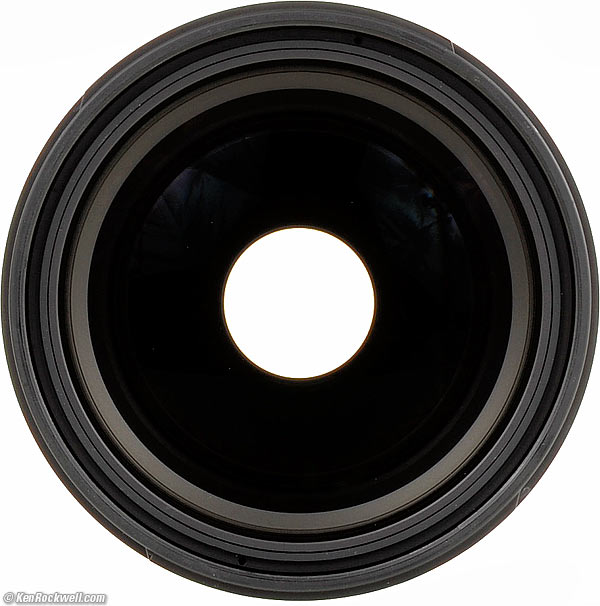
24-70mm f/2.8 wide-open at f/2.8 at 70mm. (EF diaphragm not visible).
9 rounded blades.
Reasonably round at large apertures to about f/4, and relatively straight-sided (nonagonal) from about f/8.
Stops down to f/22.
Hard Infinity Focus Stop? top
No.
You have to let the AF system focus for you at infinity.
Focus Scale top
Yes.
The ring turns from infinity to the closest focus distance in only about 30.º
Depth-of-Field Scale top
No.
Infra-Red Focus Indices top
No.
Filter Thread top
82mm.
Plastic.
Does not rotate and doesn't move with focus, but does move in and out with zooming.
Size top
Nikon mount: 3.53" (89.6mm) diameter by 4.21" (107mm) long.
Canon mount: 3.53" (89.6mm) diameter by 4.23" (107.5mm) long.
It extends as zoomed to longer focal lengths.
Weight top
35.840 oz. (1,016.1 g), measured.
Tokina specifies 35.63 oz. (1,010 g).
Hood top

Tokina 24-70/2.8 with included BH-822 hood.
Tough plastic BH-822 bayonet hood, included.
Case top
None included.
Caps top
82mm front cap.
EOS or Nikon F rear cap.
Introduced top
Nikon: 12 June 2015.
Canon: 24 July 2015.
Quality top
Made in Japan.
JAN Codes top
Nikon: 4961607696873.
Canon: 4961607696880.
Price, USA top
October 2015 - January 2016: $999 (¥ 150,000 list price in Japan).
Box, Tokina 24-70/2.8. bigger.
Performance top
Sample Images Intro Specs Performance
Compared Usage Recommendations More
Overall Autofocus Bokeh Breathing
Distortion Ergonomics Eyeblow Falloff
Filters Flare & Ghosts Lateral Color Fringes
Overall performance top
This Tokina 24-70mm f/2.8 is optically superb, but it's big and heavy.
Autofocus performance top
Autofocus isn't that fast. You can hear a small motor running while it works.
Canon and Nikon's similar lenses focus much faster and nearly silently.
This, along with the heavier weight of the Tokina, is the reason you'd want to pay more for Nikon or Canon's lenses.
Auto/Manual Switching
Just grab the focus ring and push or pull it to swap between auto and manual focus.
There is no instant override; you have to pull the ring towards you and let it click-in to get into manual mode.
AF Speed
AF speed is moderate.
An electric motor drives autofocus. You will usually hear it when it runs.
AF Accuracy and Consistency
I saw no autofocus error on my Canon 5DS R.
Especially at f/2.8, every shot is dead-on at every focal length.
Yes! Perfection!
Focus with zooming
Focus shifts slightly as zoomed, so focus last.
Manual Focus
Manual focus is easy; just pull the ring towards you until it clicks.
It's a big ring, and you have to pull it straight towards you. If you pull it unevenly, it can go sideways won't pull all the way to manual. No big, deal, just pull the other side back and you're there.
Better than Tokina's older lenses with this feature, you don't have to align anything as you move it forward or back. 90% of the time it works perfectly, the other 10% sometimes you have to jiggle it a little bit to get it to go all the way.
It takes only 30º to go from end-to-end of the focus scale, so manual focus is fast, not precise.
Bokeh performance top
Bokeh, the quality of out-of-focus areas as opposed to the degree of defocus, is good.
Of course the background rarely gets very far out of focus at 24mm; if you want soft backgrounds, shoot at 70mm, keep your subject close and shoot at f/2.8. Subject distance and focal length are more important to throwing backgrounds out of focus than simply shooting at f/2.8.
Here are samples at head-shot distance:
Ryan at lunch, 03 October 2015. (Canon 5DSR, Tokina 24-70mm f/2.8 at 34mm, f/2.8 at 1/125, Perfectly Clear V2.) bigger or camera-original © file.
On full-frame at 24mm and f/2.8. Camera-original © file.
On full-frame at 24mm and f/2.8. Camera-original © file.
If' you're looking at the camera-original files on your desktop computer, notice how insanely sharp are the spider webs, and these are shot wide-open at f/2.8.
Focus Breathing performance top
Focus breathing (the image changing size as focused) is mostly of interest to cinematographers who don't want the image changing size ("breathing") as the lens is focused among different subjects.
The image from the Tokina 24-70mm f/2.8 gets smaller as focused more closely, at all focal length settings.
Distortion performance top
The Tokina 24-70mm f/2.8 has about the same distortion as the Nikon and Canon's lenses: moderate barrel at wide, and moderate pincushion at tele. Distortion can be moderate, but it never gets totally out of control.
Use these values in Photoshop's Lens Distortion tool to remove it:
Full-Frame and 35mm at 3m (10') |
(Canon 24-70/2.8 L II) |
(Old 24-70/2.8 L) |
|
24mm |
+1.5* |
+1.5* |
+2.5* |
28mm |
+1.0* |
0.0* |
+1.5* |
35mm |
+1.0 |
-1.7 |
+0.5 |
50mm |
-2.0 |
-3.0 |
-0.7 |
70mm |
-2.5 |
-2.7 |
-2.0 |
© 2015 KenRockwell.com. All rights reserved.
* Some waviness remains.
Ergonomics performance top
Tokina 24-70/2.8. bigger.
Overall
This is a big, fat heavy lens.
Focus
The focus rings of the Nikon and Canon versions turn in different directions, the same as they do on Nikon or Canon's own lenses.
There is no AF-MF switch; you swap between modes by moving the focus ring forward and back.
Focus shifts slightly as zoomed, so focus last.
Zooming
The zoom rings of the Nikon and Canon versions turn in different directions, the same as they do on Nikon or Canon's own lenses.
Zoom is stiff and it takes a lot of turning to get from one end to the other.
The zoom is very precise and expertly spaced, making it easy to set precise framing, but it's slow if you're trying to flick in and out quickly.
Zooming ideally wants two fingers. Zooming with one finger takes a very strong and determined finger.
It certainly has no zoom creep, but it can be more difficult to zoom to 24mm when pointed straight down.
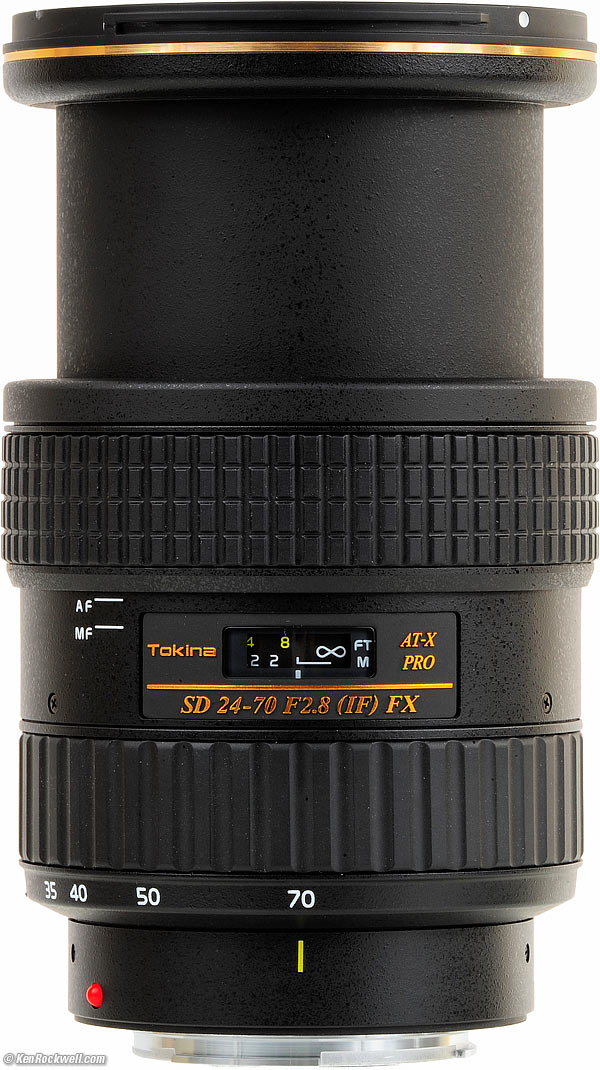
Tokina 24-70/2.8 zoomed to 70mm.
Eyeblow performance top
As a "pumper" zoom that pumps in and out as zoomed, the air has to come and go somewhere.
Yes, like many zooms, this does pull air through your camera and possibly the viewfinder.
Air pumps through the back of this lens, but I don't feel any eyeblow on my Canon 5DSR.
Falloff (darkened corners) performance top
Falloff is completely invisible, even wide-open at f/2.8.
This is great, especially because there are no lens profiles available to correct this lens.
I've greatly exaggerated this by shooting a flat gray target and presenting it against a gray background. No, I have no idea why the 24mm f/2.8 sample gets lighter at the corners, other than possibly internal reflections:
Tokina 24-70mm f/2.8 falloff on full-frame
© 2015 KenRockwell.com. All rights reserved.
|
Filters, Use with performance top
One filter is it at 24mm on full-frame before you get vignetting.
You don't need expensive "thin" polarizers or grads, unless you want to stack them.
Flare and Ghosts performance top
Flare and ghosts are extremely well controlled:
At 70mm at f/8. bigger.
Lateral Color Fringes performance top
There are nearly no lateral color fringes, which is fantastic because there are no lens profiles for this lens to help save you.
At 50 megapixels on Canon with no profile, there are some very minor green-magenta fringes at 24mm and very minor yellow-violet fringes at 70mm. You really have to look hard on a desktop computer blown up to about 200% to see them.
Nikon cameras correct this automatically without lens profiles, so I'd expect to see none on my Nikons.
Macro performance top
Mondaine A1323034811SBB at close-focus distance at 70mm on full-frame. bigger.
Macro is swell, the same as the Canon 24-70 f/2.8 L II, but not quite as close as the Nikon 24-70/2.8G.
The images would be even tighter on smaller-format cameras (see crop factor).
It's super-duper sharp; here's a crop from a 50MP image at 100%, wide-open at f/2.8:
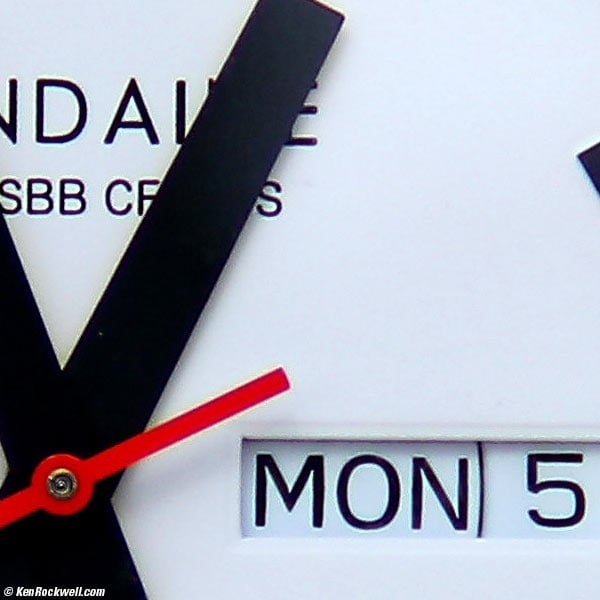
Crop from above image at 100%, shot at f/2.8 at ISO 100 on 50MP Canon 5DS R. If this is 6" (15cm) wide on your screen, the full image would print at 60 x 90" (5 x 7.5 feet or 1.5 x 2.3 meters)!
Mechanics performance top
Rear, Tokina 24-70 f/2.8. enlarge.
While the Canon 24-70mm f/2.8 L II is lighter because it's mostly made out of plastic, this Tokina beast weighs 25% more and has a lot of metal in it.
Filter Threads
Plastic.
Fore Barrel
Plastic.
Hood Mount
Plastic.
Focus Ring
Metal, rubber-covered.
Mid-barrel
Plastic.
Identity
Plate below the focus window.
Internals
Look like all metal; tougher than the Canon 24-70mm f/2.8 L II.
All the zoom barrels are solid machined alloy.
Zoom Ring
Plastic, rubber-covered.
Rear barrel
Plastic.
Dust seal at mount
Yes, but it's positioned in such a way that it doesn't seal anything on Canon.
Mount
Chromed metal.
It mounts and unmounts smoothly, just like Canon and Nikon lenses and much better than the scratchy junk from Tamron and Sigma.
Markings
Paint.
Serial Number
Printed on a sticker stuck in a recess on the bottom of the plastic lens barrel.
Date Code
None found.
Noises When Shaken
Moderately mild clunking.
Made in
Japan.
Sharpness performance top
Warning 1: Image sharpness depends more on you than your lens.
Warning 2: Lens sharpness doesn't mean much to good photographers.
While amateurs waste time worrying about lens sharpness, pros know that lens sharpness has little to do with making sharp pictures.
This said, the Tokina 24-70/2.8 is ultrasharp, even on 50 MP cameras. It is extraordinarily sharp and contrasty, even at f/2.8 right out to the corners.
So long as you're in focus, sharpness doesn't vary much from perfection, except by f/11, where diffraction softens the image. In the far corners at f/2.8 at the wide end it's just a little less sharp.
Hey, sorry to spare you endless boring charts, but with a lens this good, there's nothing to show other than sharp pictures under all conditions.
The biggest detriment to sharpness will be a lack of proper vision and technique, never this lens. I bought mine directly from Adorama. I can't vouch for anything if you buy from a local store or chain where you never really know who's opened and played with your lens before you buy it. I never buy retail; too many risks, so why pay more? Get yours only from my approved sources who ship from secure remote warehouses, otherwise since Tokina doesn't seal its boxes in any way, you have no idea what salesman or customer-induced damage your lens may have suffered. With something this expensive, don't take chances.
Here are Tokina's claimed MTF curves:
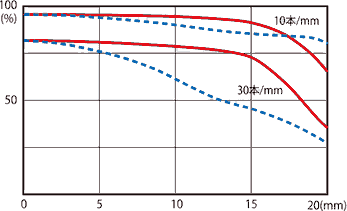
MTF at 24mm at f/2.8.
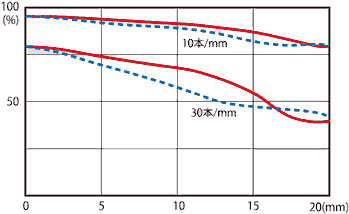
MTF at 70mm at f/2.8.
Spherochromatism performance top
I see no spherochromatism.
Spherochromatism, misnamed "color bokeh" by laymen, is when out-of-focus highlights take on color fringes. Out-of-focus highlights have no color fringes.
Spherochromatism is a completely different aberration from lateral color fringes.
Sunstars performance top
With its 9-bladed diaphragm, this Tokina 24-70mm f/2.8 makes reasonable 18-pointed sunstars on brilliant points of light at the smallest apertures:
At 70mm at f/22. bigger.
The rounded diaphragm of this Tokina prevent sunstars at most apertures.
The Canon 24-70/2.8 II makes better sunstars.
Compared top
Sample Images Intro Specs Performance
Compared Usage Recommendations More
NEW: All 24-70mm Lenses Compared.
Usage top
Sample Images Intro Specs Performance
Compared Usage Recommendations More
Since the front optical surface is flat, be sure to use a multicoated filter, otherwise you may get weird reflections between the two parallel surfaces.
Recommendations top
Sample Images Intro Specs Performance
Compared Usage Recommendations More
Would I buy one of these if I was on a budget? Absolutely!
I already own both the Nikon 24-70/2.8 G and Canon 24-70/2.8 L II because this lens didn't exist in 2007 and 2012 when I bought them.
This new Tokina is just as sharp as the Nikon and almost as sharp as the Canon, the world's sharpest midrange zoom. This Tokina lens' optics are superb.
The reasons you may want to spend much more for the Canon or Nikon lenses are:
1.) This is a heavy lens. Nikon and Canon's lenses don't feel as tough, but they are much lighter and feel more precise. I'd rather carry either the Canon or Nikon than this Tokina around all day.
2.) It's easier to zoom the Nikon and Canon lenses, while this Tokina is more precise.
3.) The Nikon and Canon lenses focus nearly silently, while this Tokina has an electric motor that makes some noise.
4.) The Nikon and Canon lenses autofocus faster.
5.) The Nikon and Canon offer instant manual-focus override, while you have to pull the focus ring towards you with this Tokina.
6.) Ten years from now, the Nikon or Canon lenses of today should work perfectly with whatever new camera you buy. Tokina can't guarantee that with this lens; Nikon and Canon don't do anything to ensure backwards compatibility with old Tokina lenses as they do for old Canon and Nikon lenses.
Therefore, for sports and action and having to carry around all day, the Nikon and Canon lenses are better.
However, for landscape shooters and anyone who works on a tripod, this Tokina lens is absolutely superb. This Tokina lens' firmer and more precise zooming may make it better than Canon and Nikon's lenses when you need the zoom to stay put, for instance when shooting HDR and pointed up or down.
DO NOT buy this lens from anyplace, especially your local retail store, unless it's on my list of approved sources, because Tokina doesn't seal its boxes in any way. If you risk buying at retail or from another online source, you'll have no way of knowing how many people have already played with your "new" lens, or if it's used, returned, incomplete or damaged. I use the sources I do because they ship from secure remote warehouses where no customers or salesmen can get their sticky hands on your new lens before you do. Approved sources have the best prices, service, return policies and selection, which is why I've been buying from most of them since the 1970s.
This all-content, junk-free website's biggest source of support is when you get yours via these links to it at Adorama, at Amazon or at B&H. When you use those or any of these links to approved sources when you get anything, regardless of the country in which you live, it helps me keep adding to this free website — but I receive nothing for my efforts if you risk buying elsewhere.
Thanks for helping me help you!
Ken.
More Information top
Sample Images Intro Specs Performance
Compared Usage Recommendations More
Tokina's USA page on the 24-70/2.8
Tokina's Japanese page on the 24-70/2.8
© Ken Rockwell. All rights reserved. Tous droits réservés. Alle Rechte vorbehalten.
Help me help you top
I support my growing family through this website, as crazy as it might seem.
The biggest help is when you use any of these links to approved sources when you get anything, regardless of the country in which you live. It costs you nothing, and is this site's, and thus my family's, biggest source of support. These places have the best prices and service, which is why I've used them since before this website existed. I recommend them all personally.
If you find this page as helpful as a book you might have had to buy or a workshop you may have had to take, feel free to help me continue helping everyone.
If you've gotten your gear through one of my links or helped otherwise, you're family. It's great people like you who allow me to keep adding to this site full-time. Thanks!
If you haven't helped yet, please do, and consider helping me with a gift of $5.00.
As this page is copyrighted and formally registered, it is unlawful to make copies, especially in the form of printouts for personal use. If you wish to make a printout for personal use, you are granted one-time permission only if you PayPal me $5.00 per printout or part thereof. Thank you!
Thanks for reading!
Mr. & Mrs. Ken Rockwell, Ryan and Katie.
Home Donate New Search Gallery Reviews How-To Books Links Workshops About Contact

